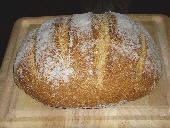In Greek: χωριάτικο ψωμί, pronounced hoh-ree-AH-tee-koh psoh-MEE
In villages around Greece, this classic bread is still baked in outdoor wood-burning ovens. This bread is more dense than other types of bread (the loaf at right measures about 13 inches across and weighs a little more than 2 pounds) and can be made with a variety of flours or a combination of more than one. If you have your own sourdough starter, use 1/2 pound (slightly less than one cup for most starters) in place of the yeast in the recipe.
Prep Time: 3 hours, 20 minutes
Cook Time: 30 minutes
Total Time: 3 hours, 50 minutes
Ingredients:
- 1 ounce of fresh yeast or 2 tablespoons of dry yeast
- 1/2 cup (4 fl.oz) of lukewarm water
- 1/2 cup (62g) of flour (whatever type used for bread)
- 2 1/5 pounds (1 kilo / 8 cups) of bread flour (whole wheat, barley, white, corn, or other)
- 1 tablespoon of salt
- 2 1/2 cups (20 fl.oz) of lukewarm water
- 2 tablespoons of milk
- 2 tablespoons of olive oil
- 2 tablespoons of honey
Preparation:
In a small bowl, dissolve the yeast in lukewarm ** water. Slowly add the 1/2 cup of flour and mix until all lumps of flour have dissolved, to form a thick liquid. Allow to rise about 15-20 minutes.
Note:
- If using sourdough starter, omit this step, and make a sponge with 1/2 pound of starter, the 1/2 cup of lukewarm water, and 1/2 cup of flour. Set aside to rise for 2 hours.
Sift the remaining flour with the salt, put in a large mixing bowl, and make a well in the center. Add oil, honey, milk, yeast mixture (or sourdough starter), and 2 cups of the water in the well. Pulling in the flour slowly, mix with hands until it’s a cohesive mass. (If more water is needed, add in small amounts from the remaining 1/2 cup.) Turn out onto a floured surface and continue kneading until the dough is nice and smooth and no longer sticks to the hands.
Place the dough in a lightly oiled mixing bowl and roll until all sides of the dough are lightly oiled. Cover the bowl with 3 dishtowels: one dry, one dampened with warm water (wet towel and wring out), and the other dry. Place in a warm place and allow to rise until doubled, about 1 1/2 to 2 hours.
Punch down and knead for 5-6 minutes on a floured surface. Divide the dough into the number of loaves you want to make (this works well in 3-4 loaves), and form into round or oblong or baguette shaped loaves. Place several inches apart on ungreased cookie sheets and cover with 3 clean dishtowels (the middle one damp). In a warm place, allow the loaves to rise for 1 hour.
Preheat oven to 450F (220C).
Note:
- The baking temperature has been adjusted down in response to reader comments.
For a thicker crust, score the tops of the loaves in 3 or 4 places (see photo). Otherwise, bake as is on the rack just below the middle of the oven for 30-35 minutes until browned. When tapped on the bottom, bread will sound hollow.
When the loaves are done, remove from oven and cool on racks.
Notes:
- Use a good “strong” flour – i.e., hard flour, also known as bread flour.
- If the honey you’re using is very thick, place the jar in a saucepan containing 1 inch of water and warm.
- No honey on hand, or don’t care for it? Leave it out.
lukewarm **:
Question: How Hot is Lukewarm?
Especially in baking, recipes usually say dissolve yeast in a “lukewarm” liquid (usually water or milk). How hot is that? Can I measure it without using a thermometer?

